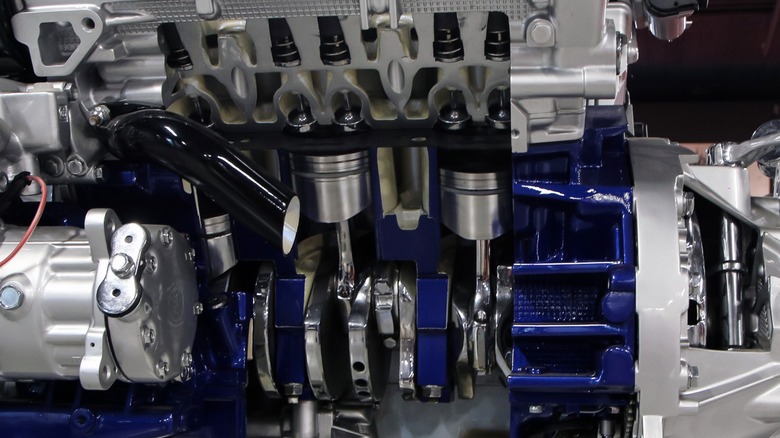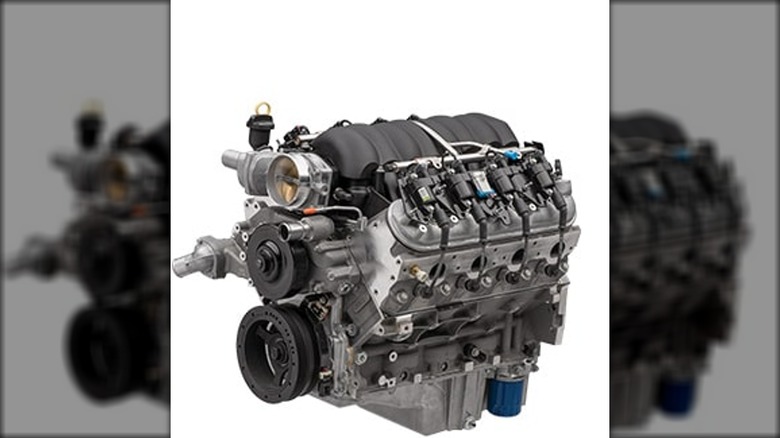GM's LS2 Vs. LS3 Engine: What's The Difference Between Them?
The small block Chevrolet engine, commonly known as the SBC, was introduced in 1955 as a 265 cubic inch V8 for the Chevy Bel Air and Corvette. While its 195 maximum horsepower and 260 lb-ft of torque were nothing to scoff at in 1955, it was just the tip of the SBC's potential.
Over the years, the SBC platform has enjoyed gains in horsepower and reliability thanks to improvements in technology and materials. It kept its original 4.40-inch spacing between cylinder centers and signature pushrod valvetrain. However, the Gen III 5.7-liter SBC LS1's new aluminum block design allowed the use of shorter pushrods by placing the single camshaft closer to the cylinder heads.
In 2005, General Motors released its fourth-generation 6.0-liter LS2 small-block V8. A short two years later, GM followed up with the Gen IV 6.2-liter LS3. While the LS2 and LS3 are from the same generation, what are the differences apart from the 0.2-liter displacement disparity?
General Motors' 6.0-liter LS2 specs
General Motors launched the Gen IV 6.0-liter LS2 small-block V8 for use in its 2005 model year Chevrolet Corvette, Chevrolet SSR, Cadillac CTS-V, and Pontiac GTO, among others. The naturally aspirated LS2 produced 400 horsepower and 400 lb-ft of torque with a 10.9:1 compression ratio and a 6,500 rpm redline in the 2005 Corvette C6. Other applications had reduced horsepower ratings. Its 364 cubic inches (6.0-liter) derives from 4.00-inch (101.6 mm) cylinder bores and a 3.62-inch (92 mm) crankshaft stroke.
The LS2's newly redesigned cast aluminum block kept the core SBC characteristics, such as 4.40-inch cylinder center spacing, pushrod-operated valvetrain, and two valves per cylinder. While the Gen IV LS2 architecture was only slightly different from the Gen III LS1 that preceded it, new technology, such as GM's Active Fuel Management system, which deactivates half of the V8's cylinders to save fuel when full power isn't needed, was introduced.
What's different about the LS3?
GM introduced the LS3 in 2007 for use in the 2008 to 2013 Corvette lineup. The LS3 was later put into service in the 2009 to 2015 Camaro SS and the short-lived Chevrolet SS from 2015 to 2017.
While the LS3 shares the same design as other SBC engines, 4.40-inch cylinder spacing, and the pushrod-based valvetrain with two valves per cylinder, some key differences exist between it and the LS2, which it ultimately replaced. The 0.2-liter (12 cubic inches) displacement difference is typically the first noticeable difference between the 6.0-liter (364 cubic inches) LS2 and the 6.2-liter (376 cubic inches) LS3. The increased displacement is due to the LS3's 0.065-inch (1.65 mm) larger 4.065-inch (103.25 mm) diameter cylinder bores over the same 3.62-inch (92 mm) crankshaft stroke. However, GM engineers reduced the LS3's compression ratio to 10.7:1 compared to the LS2's 10.9:1 ratio.
Horsepower ratings are another noticeable difference between the LS2 and LS3. Stock LS3 power peaked at 436 horsepower and 428 lb-ft of torque in Corvettes with an optional exhaust package. That represents a gain of 36 horsepower and 28 lb-ft of torque over the LS2.
Other differences include improvements to the LS3's breathability. Improved intake manifold, cylinder head, and exhaust manifold designs combine to enhance the flow of air, fuel, and exhaust gasses through the engine.


